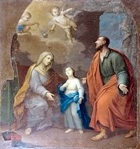

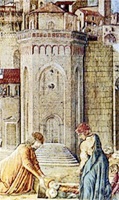
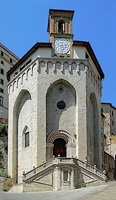
Detail of a fresco (late 15th century) by Sant' Ercolano
Benedetto Bonfigli depicting the recovery of The original upper storey.
relics of St Herculanus outside Sant' Ercolano visible in the fresco,
Galleria Nazionale (Cappella dei Priori ) was demolished in ca. 1540
This church is dedicated to St Herculanus, Perugia's patron saint. It stands outside the Etruscan walls where Totila was thought to have executed him in 549. The Commune resolved to build a church here in 1297, perhaps as a demonstration of the independence of the civic from the ecclesiastical authorities of the city. The Commune expropriated property behind the church for the construction of the sacristy in 1310. However, construction of the church was not completed until 1325, when the bell was installed in the upper church.
The fresco above shows that the church was originally built a two-storey octagonal tower that acted as a bastion of the city walls. The upper church (which had an entrance on Via Marzia) passed to the Cistercian congregation of Corpus Christi in 1381. The monks became dependent on those of San Fiorenzo when the community monks there joined their congregation in ca. 1394. [The lower church was ceded to San Domenico in 1400.]
In 1444, Pope Eugenius IV removed the Cistercians and gave Sant’ Ercolano to the Servite Observants. The upper church was demolished after the construction of the Rocca Paolina in ca. 1542 because it obstructed the line of fire of the cannons.
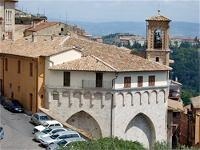
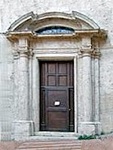
Site of demolished upper church Side door in Via Sant' Ercolano
The church seems to have been abandoned for much of the 16th century. In 1582, the Commune transferred the houses that surrounded the site of the demolished upper church and others in Via Sant' Ercolano to the family of Bishop Napoleone Comitoli. He gave this property to a community of Barnabites from Milan, whom he invited to take custody of the lower church in 1607. They adapted the properties to form their monastery.
The Barnabites remodelled the church at the behest of Bishop Comitoli, and it reopened for cult purposes in 1607. Bishop Comitoli subsequently translated relics of two saints to Sant’ Ercolano:
-
✴In 1609, he translated the relics of St Herculanus from the Duomo, and placed them in the Roman sarcophagus that still forms the high altar of the church (see below).
-
✴In 1612, he translated some of the relics of St Charles Borromeo (died 1584, canonised 1610) from Milan to a new chapel on the right wall of the church that he commissioned to receive them.
The Barnabites remained at Sant’ Ercolano until 1774, when they moved to the larger Chiesa del Gesù, following the expulsion of the Jesuits of Perugia. In 1777, Pope Pius VI sanctioned the transfer of Sant’ Ercolano to the Sodalizio di San Martino.
The church re-opened recently after an extensive restoration following the earthquake of 1997.
Exterior
The original Gothic portal of the church survives.
The fresco above depicts the semi-circular flight of stairs that originally led to the main entrance. This was built using stone that was recycled from the nearby Fontana Minore when that was demolished in 1308. It was demolished in 1524 and replaced by the structure shown (anachronistically) in the fresco (ca. 1627) by Matteuccio Salvucci illustrated below.
Bishop Napoleone Comitoli commissioned the present double flight of stairs in 1604.
Interior
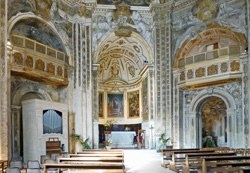
Bishop Napoleone Comitoli remodelled the interior of the church in 1607. The effect of this re-modelling was to transform the austere Gothic interior into a fine example of the Baroque.
Sarcophagus (3rd century AD)
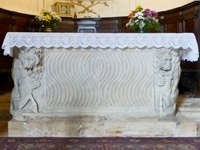
The Roman sarcophagus that forms the high altar was discovered in ca. 1609 near the small church (Sant' Orfeto) outside Perugia. Bishop Napoleone Comitoli used it for the relics of St Herculanus after their translation from theDuomo in 1609. The sides of the sarcophagus are striated and each end is decorated with reliefs of a lion eating a horse.
Copy (17th century) of Decemviri Altarpiece
This altarpiece on the high altar is a copy of the main panel of Perugino’s Decemviri Altarpiece (ca. 1495), which he painted for the Cappella dei Priori and which is now in the Pinacoteca Vaticana, Rome. It depicts the Madonna and Child with SS Herculanus, Constantius, Laurence and Louis of Toulouse.
Scenes from the life of St Herculanus (ca. 1627)
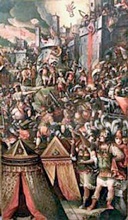
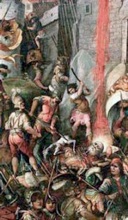
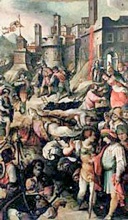
St Herculanus thrown from walls Beheading of St Herculanus Burial of St Herculanus
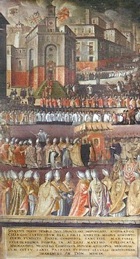
Works by Giovanni Andrea Carlone (1675)
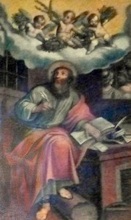
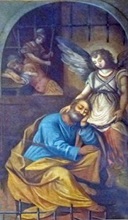
Work in the church by Giovanni Andrea Carlone include:
-
✴two panels in the apse (illustrated above), which depict
-
•St Paul writing an epistle (on the left); and
-
•St Peter in prison (on the right); and
-
✴the frescoes in the cupola, which depict:
-
•St Paul in glory with SS Gregory the Great, Augustine and John Chrysostom (in the dome itself); and
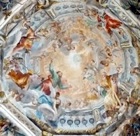
-
•scenes from the life of St Paul, in the lunettes around it, including this one of the conversion of St Paul.
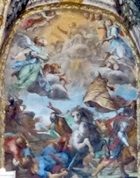
Portrait of Bishop Napoleone Comitoli (ca. 1624)
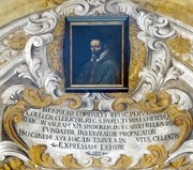
The Barnabites commissioned this portrait over the portal shortly after the death of Bishop Napoleone Comitoli.
Cappella di San Carlo Borromeo
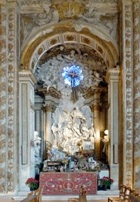
Cappella di San Martino
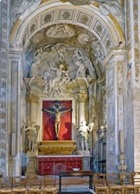
[An altarpiece (18th century) by Antonio Maria Garbi, which depicts St Herculanus reviving a dead child, is mentioned in guides but was no longer on the altar at the time of my visit of 2013]
Sacrario dei Caduti in Guerra
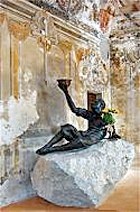
Sacristy
Virgin with SS Anne and Joachim (18th century)
Art from the Church
St Jerome (16th century)
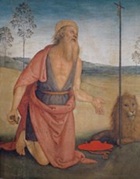
St Jerome is depicted as a hermit, kneeling in contemplation of a Crucifix, with a stone in his hand and his lion and cardinal’s hat on the ground nearby. The figure is set in a rural landscape.
